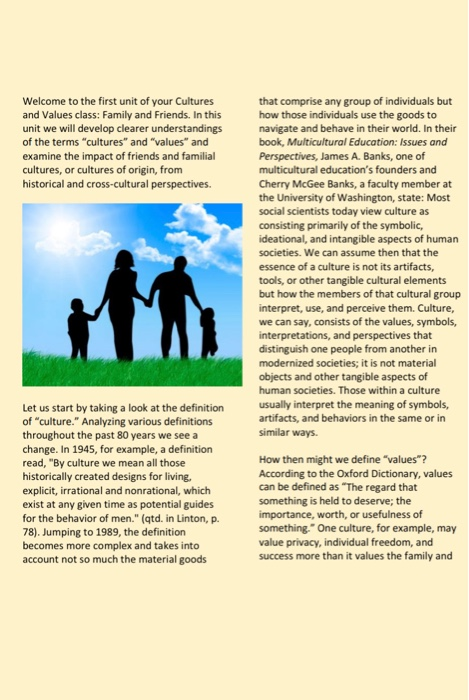Unit 1 DQ2: Familial Values and Change 15 pts Considering this units' readings, as well as your own experiences, why might a person's values and traditions shift from the ones they were raised with? Welcome to the first unit of your Cultures and Values class: Family and friends. In this unit we will develop clearer understandings of the terms "cultures" and "values" and examine the impact of friends and familial cultures, or cultures of origin, from historical and cross-cultural perspectives. that comprise any group of individuals but how those individuals use the goods to navigate and behave in their world. In their book, Multicultural Education: Issues and Perspectives, James A. Banks, one of multicultural education's founders and Cherry McGee Banks, a faculty member at the University of Washington, state: Most social scientists today view culture as consisting primarily of the symbolic, ideational, and intangible aspects of human societies. We can assume then that the essence of a culture is not its artifacts, tools, or other tangible cultural elements but how the members of that cultural group interpret, use, and perceive them. Culture, we can say, consists of the values, symbols, interpretations, and perspectives that distinguish one people from another in modernized societies; it is not material objects and other tangible aspects of human societies. Those within a culture usually interpret the meaning of symbols, artifacts, and behaviors in the same or in similar ways. How then might we define "values"? According to the Oxford Dictionary, values can be defined as "The regard that something is held to deserve; the importance, worth, or usefulness of something." One culture, for example, may value privacy, individual freedom, and success more than it values the family and Let us start by taking a look at the definition of "culture." Analyzing various definitions throughout the past 80 years we see a change. In 1945, for example, a definition read, "By culture we mean all those historically created designs for living, explicit, irrational and nonrational, which exist at any given time as potential guides for the behavior of men." (qtd. in Linton, p. 78). Jumping to 1989, the definition becomes more complex and takes into account not so much the material goods








